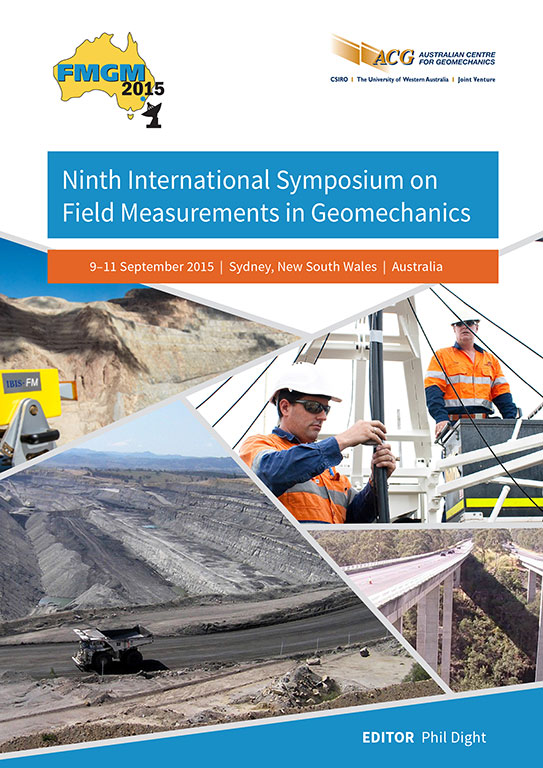The challenges of supplying good quality and useful data for significant projects

|
Authors: Beth, M; Audigé, E; Fagan, C |
DOI https://doi.org/10.36487/ACG_rep/1508_0.3_Beth
Cite As:
Beth, M, Audigé, E & Fagan, C 2015, 'The challenges of supplying good quality and useful data for significant projects', in PM Dight (ed.), FMGM 2015: Proceedings of the Ninth Symposium on Field Measurements in Geomechanics, Australian Centre for Geomechanics, Perth, pp. 47-61, https://doi.org/10.36487/ACG_rep/1508_0.3_Beth
Abstract:
Geotechnical, structural and environmental monitoring is becoming a standard requirement on construction, civil engineering and mining projects. With the amount of data to be handled, the quantity of stakeholders and the number of projects increasing very rapidly, the quality and usefulness of monitoring can sometimes be compromised. This paper reflects on the key factors influencing the success of a monitoring project. It aims at helping to convince decision makers to make the right choices when dealing with monitoring. The first steps in a monitoring program are design and specification. The authors recommend that the design is carefully thought through, on a site per site and risk per risk basis, so that the correct number and type of instruments are specified. Defining and reserving a sufficient budget for the monitoring is paramount. Unfortunately, too often an inadequate budget leads to money being spent vainly on useless monitoring. The choice of the company in charge of the monitoring must never be based solely on direct cost. This is unfortunately often the case for private contracts. On public contracts, however, there is a trend towards trying to apply the best for purpose rule, even if the decision process remains a complex task. During monitoring project implementation, the engineer or the client should ensure that they have the will, the power, and the tools to demand high quality data. This can only be achieved if the monitoring rules are previously planned and well defined at the specification stage. The experience and dedication of the monitoring team has a huge impact on data quality. Instrument installation and readings must be carried out according to predefined methods and quality control procedures. Both manual and automatic instrumentation must be implemented, their ratio depending on the site specific characteristics. Finally, the monitoring tools usually contained within the monitoring database software must bring added value to help the stakeholders understand the state of their project and risks involved. This includes data fusion (mixing data of different types), alarm management, dashboard and weather map presentations and a journal of events and reporting tools.
References:
AFTES 1998, ‘Recommandations relatives à l’organisation de l’auscultation des tunnels’, Tunnel et ouvrages souterrains, vol. 149.
Association Francaise de Normalisation 2014, NF EN ISO 18674:2013: Geotechnical Investigation and Testing – Geotechnical Monitoring by Field Instrumentation – General Rules, Association Francaise de Normalisation (AFNOR), Paris.
Beth, M & Obre, X 2005, ‘Ground movement monitoring at Kings Cross Station, London’, Proceedings of the Institution of Civil Engineers – Geotechnical Engineering, vol. 158, no. 3, pp. 125-133.
Beth, M, Pezzetti, G & Schmuck, C 2011, ‘Urban Excavation Instrumentation: Analysis and reflexions’, Proceedings of the Eighth International Symposium on Field Measurements in Geomechanics, Technische Universität Braunschweig, Berlin.
British Tunnelling Society 2012, ‘Monitoring underground construction: a best practice guide’, ICE Publishing, London.
Dunnicliff, J 1993, Geotechnical instrumentation for monitoring field performance, John Wiley & Sons, Inc., New York, NY.
European Standard 2004, EN 1997-1 Eurocode 7: Geotechnical Design – Part 1: General rules, European Committee for Standardization (CEN), Brussels.
European Standard 2007, EN 1997-2 Eurocode 7: Geotechnical Design – Part 2: Ground Investigation and Testing, European Committee for Standardization (CEN), Brussels.
ITAtech 2014, ITAtech guidelines on monitoring frequencies in urban tunnelling, report N°3-V2, ITAtech, Lausanne.
Vargas, B & Beth, M 2012, ‘Observational method using real time surface settlement monitoring: the South Toulon Tunnel Project’, in RD Hryciw, A Athanasopoulos-Zekkos & N Yesiller (eds), Proceedings of GeoCongress 2012, American Society of Civil Engineers, Reston, VA, pp. 3109-3118.
Vargas, B & Beth, M 2014, ‘Urban tunnel monitoring: what’s next?’, in G Davidson, A Howard, L Jacobs, R Pintabona & B Zernich (eds), Proceedings of the North American Tunnelling, Society for Mining, Metallurgy & Exploration, Englewood, CO,
pp. 42-48.
© Copyright 2024, Australian Centre for Geomechanics (ACG), The University of Western Australia. All rights reserved.
View copyright/legal information
Please direct any queries or error reports to repository-acg@uwa.edu.au
View copyright/legal information
Please direct any queries or error reports to repository-acg@uwa.edu.au